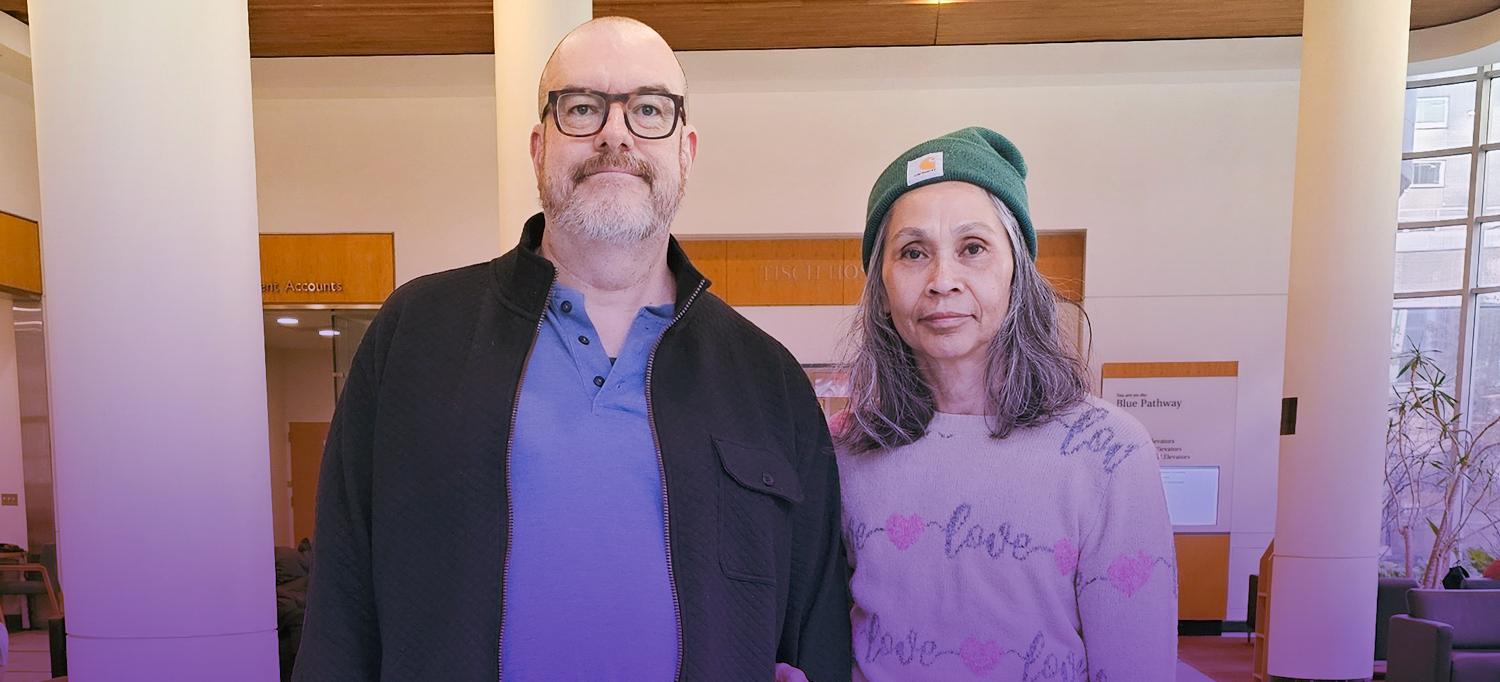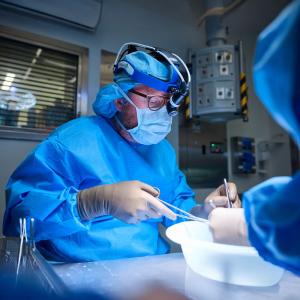
Credit: NYU Langone Staff
When Vincent Scafuri needed a lifesaving kidney transplant due to advanced polycystic kidney disease (PKD), his wife, Griselda Espinosa, offered to be his kidney donor. After extensive screening, the news was not what the couple expected. Although the couple shared the same blood type, O, Espinosa was not a match for her husband. But all was not lost.
Espinosa could donate her kidney to a stranger through the National Kidney Registry (NKR) Voucher Program. And in return, Scafuri would get bumped up to the top of the Voucher Program’s living donor transplant list. This would provide him the opportunity to receive a living donor kidney that was a better match.
“The National Kidney Registry Voucher Program allows someone to donate a kidney on behalf of their loved one. They donate their kidney into the pool, then their intended recipient gets a voucher to get a kidney out of the pool when it becomes available. It’s really that simple,” says Michael Lollo, chief strategy officer for the National Kidney Registry. “The average wait time for a donor kidney for voucher holders with blood type O is an average of six months,” Lollo says, “but it’s often much less for people with other blood types.”
Scafuri was skeptical about the Voucher Program at first. “I was expecting to get a kidney directly from my wife. If she donates her kidney to someone else through the National Kidney Registry, am I really going to be at the top of the kidney donor waitlist? I wasn’t sure,” he says.
“Overall, the experience was much easier than I thought it was going to be, and the surgeons and nurses were amazing. I can’t say enough good things about them.”
—Vincent Scafuri
Ultimately, though, the Red Hook, Brooklyn, couple, who have been together since 1999, decided to trust the Voucher Program process and the expertise of the NYU Langone Transplant Institute team, who provide world-class care with superior outcomes to people in need of a kidney transplant. NYU Langone is the highest-volume program in New York State for kidneys from both deceased and living donors. The couple entered the Voucher Program in September 2023.
Desperate for a Kidney Transplant
Scafuri was diagnosed with PKD in 2009 at age 30. A genetic condition, PKD causes cysts to develop in the kidneys. “The cysts grow larger and heavier over time and interfere with normal function,” says Nicole M. Ali, MD, medical director of kidney transplantation at NYU Langone. Scafuri had been managing the condition with diet and blood pressure medication to help prevent cysts from developing. After 23 years, however, the disease was taking a toll. When Scafuri wasn’t on dialysis, “I was so tired that I could only work from bed,” he says.
“Dialysis replaces the work of failing kidneys, but it can lead to an increased risk of heart disease over time,” says Jeffrey M. Stern, MD, NYU Langone kidney transplant surgeon. “To donate a kidney to get someone off dialysis or prevent someone from going on dialysis is the most remarkable gift one human can give to another.”
To give a kidney to a stranger is an even rarer gift.
Kidney Donation to a Stranger
On December 21, 2023, Espinosa had surgery at NYU Langone to donate one of her healthy kidneys through the National Kidney Registry. “The kidneys are vitally important; they filter toxins from the blood,” Dr. Ali says. “But as long as you’re healthy, you don’t need two kidneys.”
In exchange, Scafuri was activated on the National Kidney Registry waitlist and received an electronic voucher for a living donor kidney. With a better donor kidney match, Scafuri would likely require less immunosuppression than the standard transplant, with expectation of longer kidney survival, Dr. Ali says.
Meanwhile, Scafuri started extensive medical testing to prepare for future kidney transplant surgery. And because he hadn’t had surgery yet, he was available to care for his wife at home as she recovered from surgery.
A Better Kidney Match Becomes Available
Only 54 days after receiving his voucher, a better kidney match became available for Scafuri from a living donor in Pennsylvania. On February 13, 2024, Scafuri’s donor kidney was packed in ice and transported to NYU Langone.
Shortly after midnight on February 14, 2023—which happened to be the couple’s first anniversary—Dr. Stern performed Scafuri’s transplant recipient surgery. During the four-hour operation, Dr. Stern was able to fit the new kidney in Scafuri’s pelvis without removing his poorly working kidneys, which is the standard of care.
“There’s no reason to take out the kidneys unless they cause pain, trouble eating, or chronic kidney or urinary tract infections,” Dr. Stern says. Since Scafuri wasn’t experiencing any of those symptoms, it was safe to leave his natural kidneys in; they will continue to shut down while his new healthy kidney takes over. “Living donor kidneys generally work well right away and have much fewer complications than kidneys from a deceased donor,” Dr. Stern says, which was the case for Scafuri, with Espinosa recovered from her operation and able to care for her husband after his surgery.
“Overall, the experience was much easier than I thought it was going to be, and the surgeons and nurses were amazing,” Scafuri says. “I can’t say enough good things about them.”
“Getting a new kidney is like the first day of the rest of your life. And that’s why I love my job. I get to spread joy every day,” Dr. Stern says. “As a transplant surgeon, my hope is that I get to high-five my patients years later and say, ‘Your kidney is working great!’”

